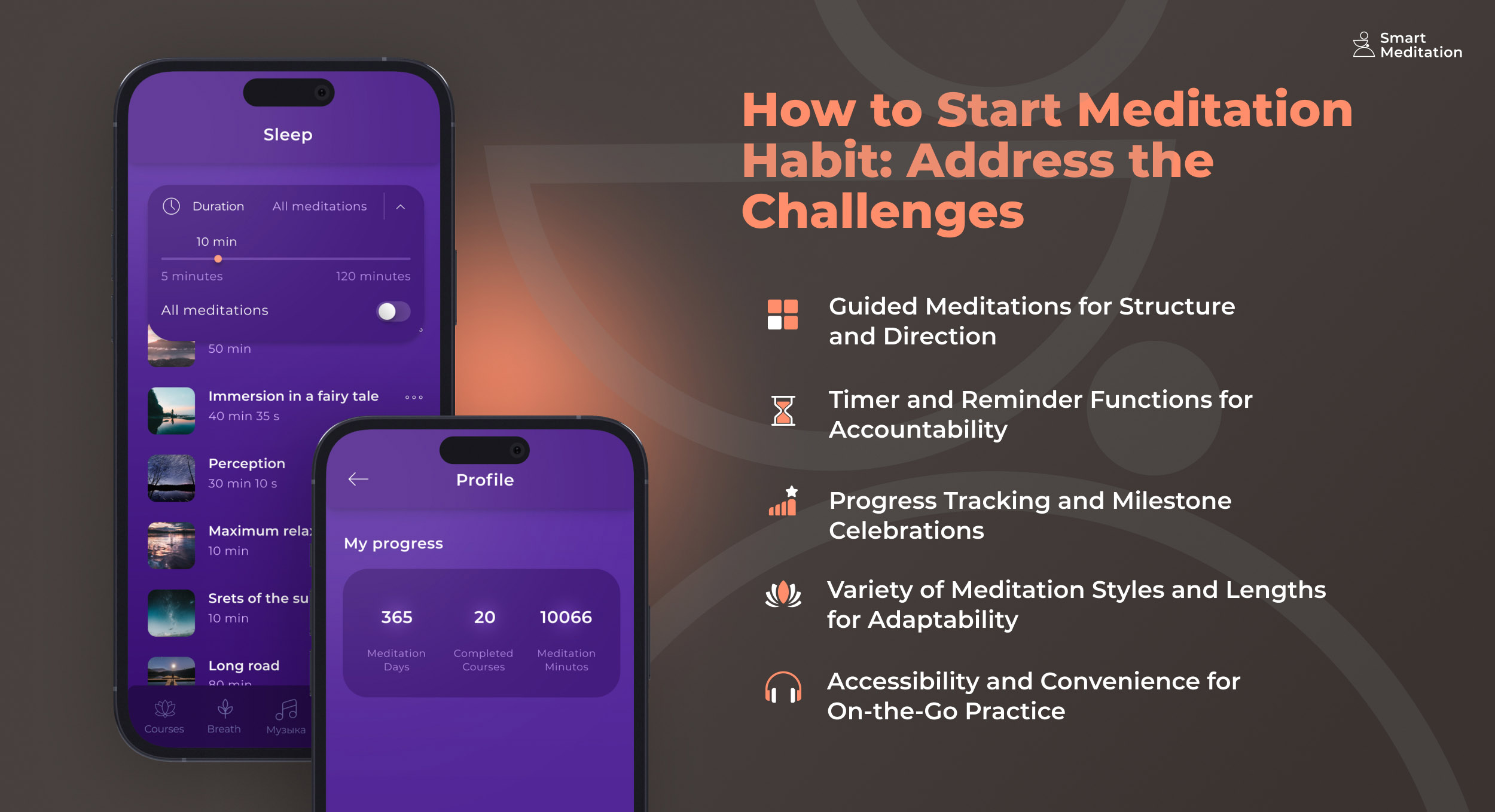
How Meditation Apps Can Help You Build a Consistent Practice
Meditation is known to have greatly positive effects both on mind and body. But like with any good habit, for it to work, you need to be consistent.
Consistent daily meditation practice can be hard to achieve, especially when you’re just starting out; luckily, solutions like meditation apps can massively help you stay motivated.
In this article, we’ll talk about common obstacles that you may face when trying to stay consistent, and how using a meditation app can help you overcome those obstacles.
Understanding the Challenges of Establishing a Consistent Daily Meditation Practice
Before we can understand how to start a daily meditation practice correctly, we need to understand what challenges we may deal with along the way:
Common Obstacles Faced by Beginners and Experienced Practitioners
Whether you’re a novice or a seasoned practitioner, starting a regular meditation routine can be rather difficult. Beginners sometimes struggle with adapting to the meditation practices, finding it difficult to quiet the mind, or feeling uncomfortable when sitting still for long periods of time. Conversely, seasoned practitioners may run into challenges like complacency or a sense of being trapped in their work.
Lack of Accountability and Motivation
Without any outside support, it’s simple to fall off the wagon and lose sight of our meditation practice. It’s typical to struggle with consistency when we don’t have a set schedule to hold us responsible. That’s why having external responsibility can greatly increase our commitment to regular practice – that includes taking a meditation class or taking part in group meditations. We can also maintain our motivation and dedication to our practice by doing it together with a friend, using reminder applications, or keeping track of our progress.
Difficulty in Sustaining Focus and Overcoming Restlessness
It can be challenging to be fully present during practice since our brains have a propensity to wander and get unrestful. Naturally, it can make us frustrated, but luckily there are a number of methods we can learn to improve our concentration, such as using our breath as an anchor or focusing on our bodily sensations.
How to Start Meditation Habit: Address the Challenges
We’ve already glanced over some tips on how to be consistent in the previous section; how let’s dive deeper into how to start a meditation habit:
Guided Meditations for Structure and Direction
Guided meditations are great for building consistency – they offer structure and assistance, which is especially important for beginners who might not know where to start. Step-by-step directions, comforting voices, and relaxing background music are all features of guided meditations that make them both pleasant and effective. What also helps is that there are numerous kinds of courses and tracks out there. So it doesn’t matter whether you prefer mindfulness, loving-kindness, or body scans – you’ll be able to find anything that works best for you.
Timer and Reminder Functions for Accountability
You can also overcome inconsistency by incorporating a timer and reminder features into your routine. Set aside a specific time period during the day that’s dedicated to nothing but your meditation and set up your reminders accordingly. They foster responsibility and dedication to your practice by making you stick to your promises and letting you know that a time to have a session has come.
Progress Tracking and Milestone Celebrations
Some meditation apps have progress monitoring capabilities that let you log your sessions and view your session history, giving you an idea of how consistent you are and where you can improve. On top of that, celebrating achievements, such as finishing a set number of consecutive days or hitting particular meditation objectives, strengthens your resolve and motivates you to carry on.
Variety of Meditation Styles and Lengths for Adaptability
To meet your hectic schedule, you may need to meditate for shorter periods of time on certain days, and it’s completely normal. Remember that you can always compensate for it on other, less busy days when you can in more prolonged sessions. Also learn to have the flexibility to explore and experiment with the various meditation techniques such as mindfulness, breathing exercises, mantras or chakras. This keeps your practice fresh and allows you to tailor your meditation sessions to your present state of mind or energy level.
Accessibility and Convenience for On-the-Go Practice
Finally, try to find methods to include meditation into your daily life no matter where you are or how busy you are, whether it be via the use of a meditation app, carrying a portable meditation cushion, or using audio-guided meditations you can listen to on the go. Doing so makes it possible for you to cultivate a regular meditation practice that flows seamlessly with your individual rhythm and benefits your wellbeing.

Features and Tools in Meditation Apps to Support Consistency
In this section we’ll focus on specific features that you should look for in meditation apps when looking to build your daily meditation schedule:
Meditation Reminders and Notifications
As we mentioned earlier, setting reminders and getting notifications is a very useful feature of meditation apps for consistency-building purposes, so it’s a must-have. The prompts that gently remind you to meditate at particular times during the day help you stay focused on your commitment and not skip sessions because of simple forgetting.
Personalized Meditation Plans and Programs
A lot of meditation apps also provide tailored meditation regimens that take into account things like your degree of experience, your free time, and your areas of interest. Following a structured program that was created just for you can feel very satisfying – the program usually features a carefully chosen assortment of mindfulness exercises, guided meditations, and other supporting materials.
Meditation Challenges and Streaks for Motivation
Challenges are another great function for establishing consistency – you can set certain goals for you to reach over a predetermined time frame and get yourself extra motivation to do well. Meanwhile, the streak reminders that some apps can send will feel like a reward that praises you for practicing a number of days in a row.
Journaling and Reflection Features
With meditation apps, you can also record your thoughts, experiences and even your personal breakthroughs before or after your meditation sessions using the journaling function. This way, you get to reflect on your progress, express appreciation for yourself and track your mental patterns, among other things. And it has been proven that this kind of writing leads to a more fulfilling meditation experience.
Community and Social Engagement Options
Last but not least, you can connect with other people who share your interests in meditation by using the community and social interaction features that many meditation apps provide. Being part of a group of like-minded people will encourage and inspire you to stay dedicated; moreover, you can get valuable advice from more experienced practitioners on different forums for exchanging knowledge.
Establishing a Consistent Meditation Routine with the Help of Apps
Lastly, we’d like to provide you with some solid tips on how to leverage the power of meditation apps to the full and create an enjoyable daily meditation practice for yourself:
Setting Realistic Goals and Expectations
It’s crucial to set reasonable expectations and keep them in check, otherwise it’ll be easy to get frustrated when trying to achieve the nearly impossible. Decide how often and for how long you’d want to meditate each day or each week and note your schedule down in your meditation app. Naturally, it’s strongly recommended to begin with a modest objective that you are sure you can accomplish and then progressively increase the duration and frequency of your sessions overtime.
Creating a Meditation Schedule and Rituals
Related to the above tip, making time for meditation each day and implementing rituals will help your practice become second nature. Whether it’s early in the morning, during your lunch break, or late at night, pick a slot that suits you best and after some time your body itself will start telling you that it’s time to meditate. And when it comes to rituals, you can try incorporating something that gives you pleasure as a to-do thing before your sessions – this could be lighting an aroma candle or playing some relaxing music.
Incorporating Meditation into Daily Life
Finally, it’s important to try to use the concepts and methods you discover when meditating in your everyday activities. Learn to be more aware of yourself and your environment not just when meditating, but also eating, walking, or doing chores. Also make sure to take small breaks throughout the day to stop whatever you’re doing, breathe in deeply, and focus on the present moment for a couple of seconds. And how can the app help with that? It can give you creative ideas for such small integrations and send reminders to do some short mindfulness at certain times of the day.

Conclusion
How to start a daily meditation practice with the help of meditation apps? In a nutshell, create a personalized meditation plan, set up reminders, goals and challenges, and get going. And while at it, don’t forget to journal your experiences, engage in conversation on community forums and try integrating meditation in your everyday activities.
And if you ever feel like you’re losing motivation or your practice is becoming too mundane, feel free to experiment with various guided meditation programs you can find, for example, in our Smart Meditation app.






